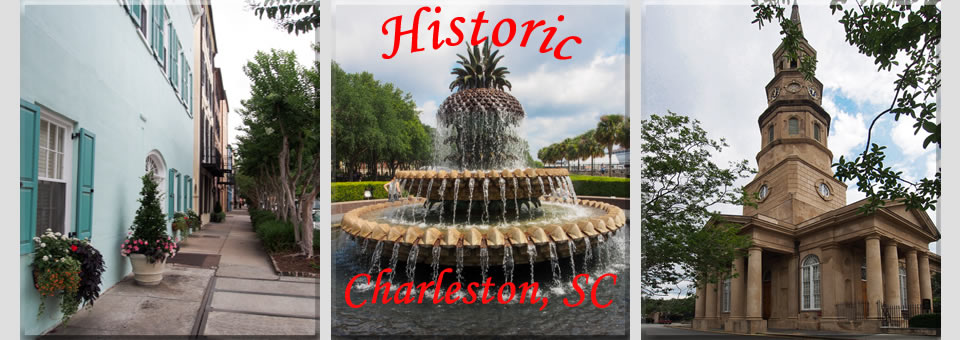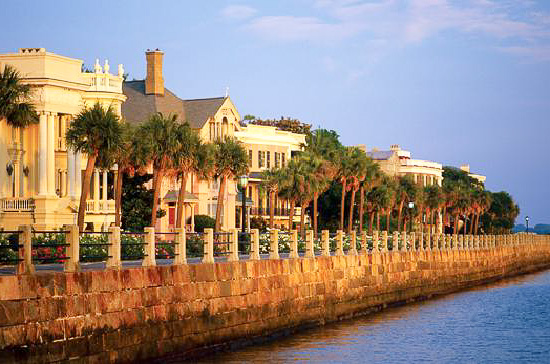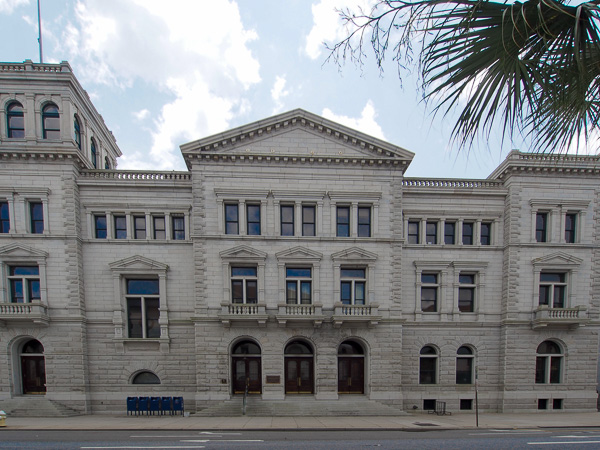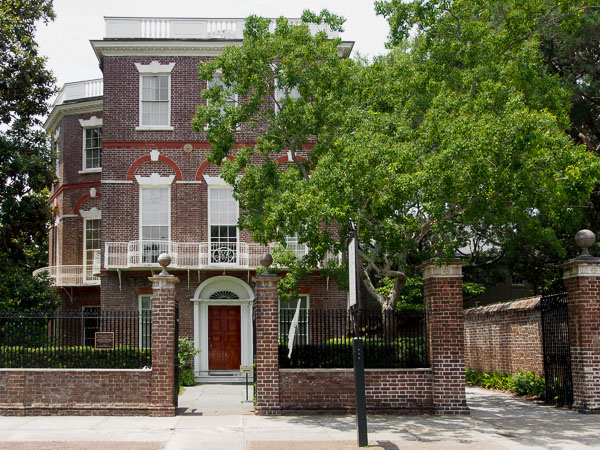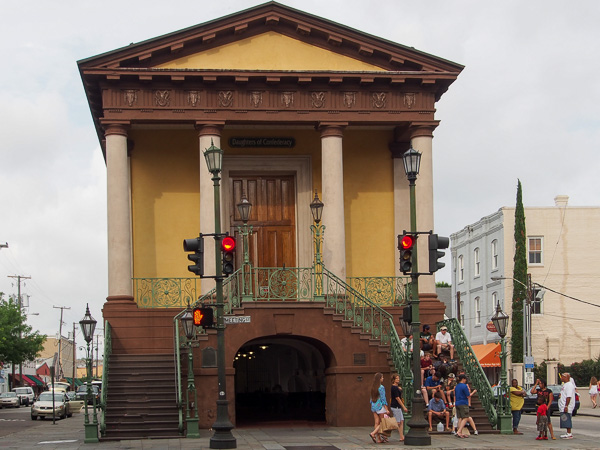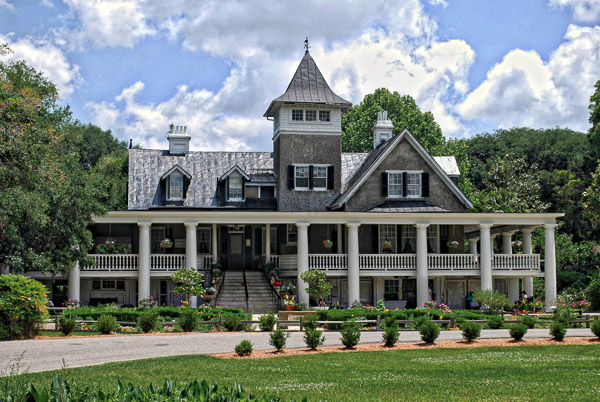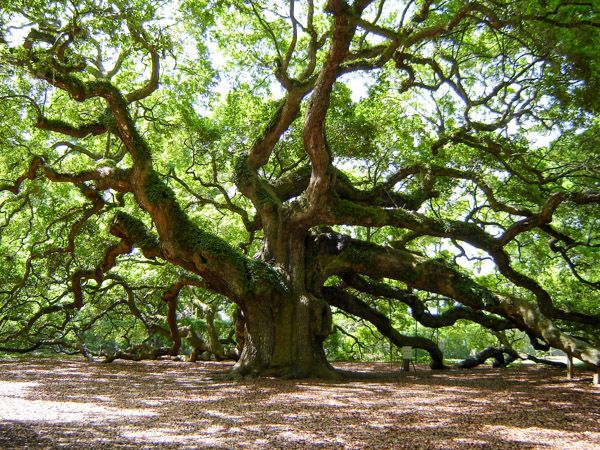- - - - - - - - - - - - - - - - - - - - - - - - - - - - - - -
Top 15 Must See Attractions and
Fun Things to do in Charleston, SC
- - - - - - - - - - - - - - - - - - - - - - - - - - - - - - -
1) Walking Tour
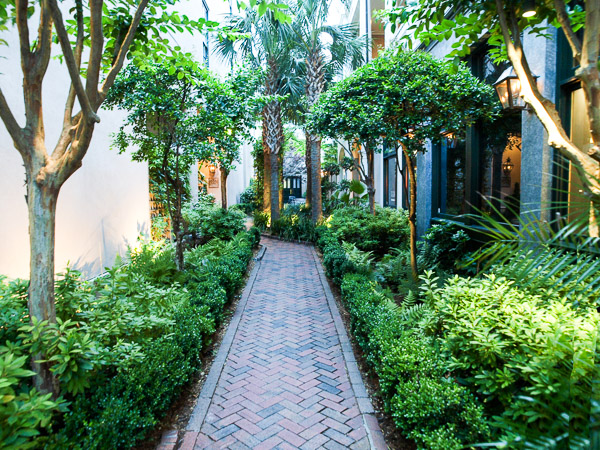
One of the best ways to learn about the history of Charleston is to take a walking tour of the city. Charleston is defined by its cobblestone streets, horse-drawn carriages and pastel antebellum houses, particularly in the French Quarter and Battery districts.
There are many walking tours to choose from and most tours last about two hours and cost $20.00 per person. You will want to wear sturdy shoes and sunscreen, also bring water when visiting in the summer.
Time to Spend: 2 hours
For information about Walking Tours
- - - - - - - - - - - - - - - - - - - - - - - - - - - - - - -
2) The Battery & White Point Gardens
Charleston, SC 29401
(843) 724-7327
The Battery is one of the most famous landmarks in the city. The seawall stretches from the lower shores of the peninsula and was formerly used for defensive purposes. Along the city's southern tip is a row of Southern-style mansions overlooking Charleston Harbor and was formerly the heart and soul of the city's maritime activity. The Battery is famous for its stately antebellum homes.
White Point Gardens is 5.7 acres and stretches along the city's southern tip. Visitors can have excellent views of the Fort Sumter and Charleston harbor from the White Point Garden. The park has numerous old oak trees and plenty of open spaces.There you will find paved paths, a gazebo, military statues and monuments, cannons and picnic areas as well as several Civil War relics and memorials commemorate the city's role in the battle. Along East Battery are the 11-inch Dahlgren gun that fired shells at For Sumter in 1863 and two Confederate columbiads (large cannons) that were used in the defense of Fort Sumter. On Murray Blvd. there are several more artillery pieces: a rare 7-inch Brooke rifle (a large cannon) that was found at Fort Johnson and four 13-inch Union mortars (weighing 17,000 pounds each). On the King Street side is a 1918 World War I howitze.
Time to spend: 2 hours to half-day
- - - - - - - - - - - - - - - - - - - - - - - - - - - - - - -
3) Rainbow Row
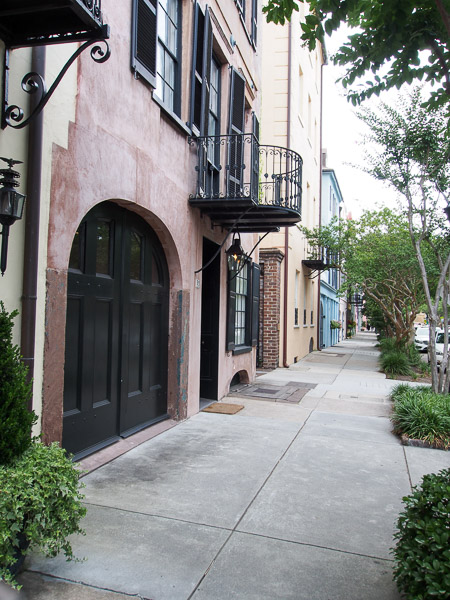 Rainbow Row
Rainbow Row
 Rainbow Row
Rainbow Row
 Rainbow Row
Rainbow Row
Charleston, SC 29401
Rainbow Row is the name for a row of thirteen colorful historic houses in Charleston. It is the longest cluster of Georgian row houses in the United States. These homes were built in the mid 18th century. The houses, spanning from 79 to 107 East Bay Street, are named so after the bright pastel colors they were painted during their restoration process in the 1930s and the 1940s. Dating back to 1740, the Rainbow Row is situated near the historic waterfront of the city. As the houses were being restored in the 1930s and 1940s they were painted with pastel colors, therefore the name "Rainbow Row.
Today, Rainbow Row consists of 14 private residences that are part of one of the most famous architectural landmarks in Charleston. It is considered to be the most photographed area of historic Charleston.
Time to spend: 30 mins to 1 hour
- - - - - - - - - - - - - - - - - - - - - - - - - - - - - - -
4) Postal Museum
Charleston, SC 29401
The United States Post Office and Courthouse was built in 1896. The building has a Renaissance Revival style with a lavish interior and is indicative for elaborate public buildings of the late 19th century. Grey granite from Winnsboro, South Carolina was used along with a square corner tower, rusticated quoins, and balustraded balconies to create a palatial and imposing exterior. The Post Office occupies the first floor and is decorated with carved mahogany woodwork, a marble staircase, brass and ironwork, and stone columns. The second floor contains a paneled Victorian courtroom.
As you walk into the lobby you feel as if you have stepped back in time. There is an old phone, typewriter and mail box. The old postal window is set up just as it would have been many years ago. The museum, located in the lobby, is a one room filled with displays and the importance of the mail in the growth of Charleston. There are ink stamps with ink, carrier bicycles, typewriters, photographs, post office memorabilia, old stamps and newspaper clippings.
The United State Post Office and Courthouse is located at 83 Broad Street is the oldest continuously operated post office in the Carolinas.
Time to spend: 1 to 2 hours
Lobby Hours:
Monday - Friday: 7:00a - 5:00p
Saturday: 7:00a - 12:00p
Museum Hours:
Monday- Friday: 11:30a - 3:30p
- - - - - - - - - - - - - - - - - - - - - - - - - - - - - - -
5) Nathaniel Russell House
 Nathaniel Russell House
Nathaniel Russell House
 Nathaniel Russell House
Nathaniel Russell House
Charleston, SC 29401
(843) 724-8481
Nathaniel Russell House is a historic house built by the wealthy shipping merchant Nathaniel Russell in 1808. It is one of the most significant neoclassical houses in the United States. One interesting feature in the house is an elliptical spiral staircase which ascends three floors. The Adamesque ornamentation of the fireplaces' mantles and cornices are among the most detailed in the city. This 19th-century mansion is home to an extraordinary circular dining room and self-supporting three-story spiral staircase.
A visit to the Nathaniel Russell House provides a detailed understanding of wealthy families during the economic booms of the 19th century. The house has three main rooms on each floor with diverse geometric designs - a front rectangular room, a center oval room and a square room in the back.
There are slave quarters behind the house which were used to accommodate 18 slaves who served the Nathaniel Russell House.
An exhibition in the original kitchen house highlights artifacts uncovered during archaeological investigations at the site—pottery sherds, beads, and part of a slave tag. These objects reveal the everyday duties performed by slaves and the spiritual beliefs of the enslaved men and women that maintained the grand townhouse.
Today, the interiors are restored to their original 1808 grandeur and surrounded by formal gardens.
Time to spend: 2 hours
Hours:
Monday - Saturday 10:00a - 5:00p
Sunday: 2:00p - 5:00p
- - - - - - - - - - - - - - - - - - - - - - - - - - - - - - -
6) Calhoun Mansion Museum
 Calhoun Mansion Museum
Calhoun Mansion Museum
 Calhoun Mansion Museum
Calhoun Mansion Museum
Charleston, SC 29401
The Calhoun Mansion is a 24,000 square foot 35-room Italianate mansion built in 1876 at a cost of around $200,00 and the lot was purchased at $40,000.The construction of the house took five years. The Italianate style home consists of 35 rooms and 23 period fireplaces. It was once the finest private residence in South Carolina. The 24,000-square-foot gilded-age mansion is equipped with 30 well decorated rooms and five smaller rooms.
The grand entrance hall is 14 feet high by 14 feet wide and is 65 feet in length. The house has 14 foot ceilings, ornate plaster and wood moldings, elaborate chandeliers, a stairwell that reaches to a 75 foot domed ceiling, and a music room with a 45 foot covered glass skylight. The Mansion also includes beautiful decorative paintings and lighting designed and installed by Louis Comfort Tiffany at the turn of the twentieth century. The Calhoun Mansion also features original walnut and oak woodwork, gas chandeliers, and Minton encaustic tiles. It still remains the largest single family residence private home and house museum in Charleston. On a visit to Calhoun Mansion, make sure to explore the beautiful gardens surrounding the house.
Guided tours are conducted every hour and a half with a knowledgeable guide who shares original stories related to the house all through the tour.
One of the locations used in the filming of Nichaolas Spark's "The Notebook".
Time to spend: Half day
Tours:
Begin at 11:00a on the hour and half-hour (Last tour is at 5:00p)
Seasonal Schedule
December - February Tours: 11:00a - 4:30p Daily
March - November: 11:00a - 5:00p Daily
Thanksgiving Day & Christmas Day: Closed
- - - - - - - - - - - - - - - - - - - - - - - - - - - - - - -
7) Waterfront Park

Waterfront Park
 Waterfront Park
Waterfront Park
 Waterfront Park
Waterfront Park
Charleston, SC 29401
Waterfront Park is a twelve-acre park along approximatley one-half mile of the Cooper River in Charleston. Waterfront Park opened in 1990 and one of the most visited parks in South Carolina which offers amazing views of the Charleston Harbor. Gardens, fountains, walking paths and numerous park benches are all available on the property. One of the attractions is the large fountain at the northern entrance of the park with a wooden pier that extends to the Cooper River. A floating dock near the fountain offers clear views of the Ravenel Bridge, Charleston Harbor, Castle Pinckney, the U.S.S. Yorktown at Patriot's Point and Fort Sumter. It is also a good place to sit, relax and watch the sailboats cruising the waters and large ships heading in and out of the harbor.
The park has two fountains for children to enjoy splashing in the water during hot summer days. One of the fountains is the famous Charleston Pineapple Fountain which resembles a pineapple.
Time to spend: 1 - 2 hours
- - - - - - - - - - - - - - - - - - - - - - - - - - - - - - -
8) Charleston City Market
 Charleston City Market
Charleston City Market
 Charleston City Market
Charleston City Market
Charleston, SC 29401
The Charleston City Market was established in the 1790s. The market covers four city blocks which included the significant Market Hall, which faces Meeting Street, through a continuous series of one-story market sheds, the last of which terminates at East Bay Street. The Market Hall has been described as a building of the "highest architectural design quality.
The main building was built in 1841 and is an apparent modification of the Grecian-Doric temple of "The Wingless Victory" at Athens. The cornice is ornamented with ram's and bull's heads, a survival of the Greek custom of hanging in the temple skulls of animals sacrificed to the gods, later symbolized in conventional architecture.
Charleston's City Market was developed as a replacement for the city's Beef Market building which burned in 1796. Market Hall was added in the early 1840s. Throughout the 19th century, the market provided a convenient place for area farms and plantations to sell beef and produce, and also acted as a place for locals to gather and socialize. It is one of the major and oldest public markets in the United States.Today, the City Market has over 300 vendors who sell souvenirs and other items ranging from jewelry to Gullahsweetgrass baskets.
Time to spend: 1 hour to half day
Hours:
Sunday - Saturday: 9:30a - 5:00p
Night Hours:
Friday - Saturday: 6:30p - 10:30p
- - - - - - - - - - - - - - - - - - - - - - - - - - - - - - -
9) Old Exchange & Provost Dungeon
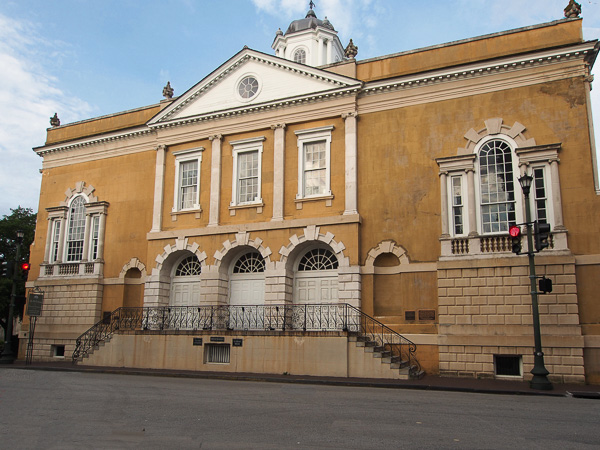 Old Exchange & Provost Dungeon
Old Exchange & Provost Dungeon
 Old Exchange & Provost Dungeon
Old Exchange & Provost Dungeon
Charleston, SC 29401
(843) 727-2165
The Exchange and Provost, also known as the Custom House, was where many significant events of the American Revolution and early Federal period occurred. The Old Exchange and Provost Dungeon is considered as one of the oldest historic buildings here. Provost Dungeon was used to chain the prisoners held by the British during the Revolutionary War.
As Charleston became the South's largest port, the Exchange and Custom House was built from 1767 to 1771 for the expanding shipping industry, but also served as a public market and meeting place. Confiscated tea was stored in the building in 1774 after the protest meeting against the Tea Act. The British used the building as barracks and the basement as a military prison during the Revolutionary War. The State Legislature met in the building in 1788 after the Statehouse was destroyed and in 1791 a grand ball was held here for George Washington when he visited Charleston.
The symmetrical Georgian style building is two stories with an elevated basement and hipped roof. The central projecting pavilion on the main side of the building and tall Palladian windows are typical classical details of the Georgian period. Originally the building fronted the harbor, but during the past two centuries several blocks have been created by landfill between the Exchange and the water. In the 19th century the building was used mainly as a post office and customhouse. In 1879 a new United States Custom House was built and the Exchange was no longer needed to conduct Port business.
Visitors can tour its three floors that highlight numerous features of Charleston history throughout the Colonial and Revolutionary periods.
Time to spend: 2 hours to half-day
Hours: Open daily 9:00a - 5:00p
- - - - - - - - - - - - - - - - - - - - - - - - - - - - - - -
10) Old Slave Mart Museum
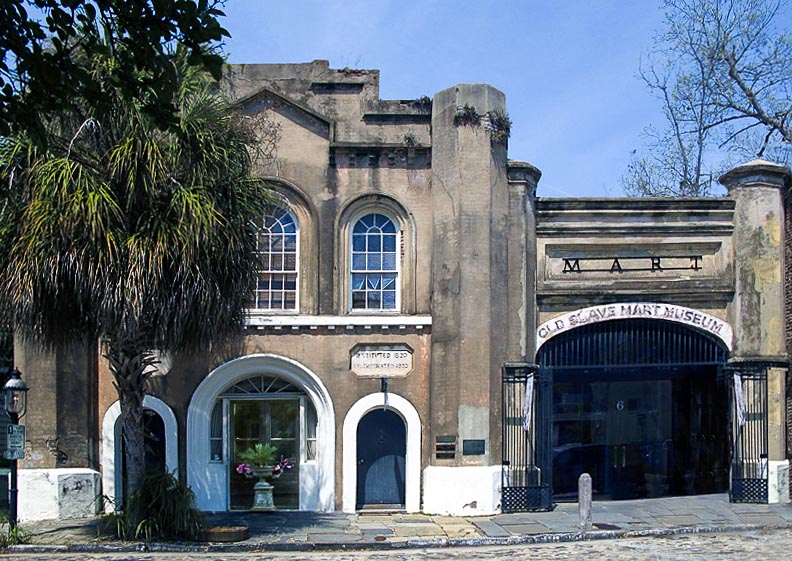 Old Slave Mart Museum
Old Slave Mart Museum
Charleston, SC 29401
(843) 958-6467
The Old Slave Mart, located on one of Charleston's few remaining cobblestone streets, is the only building still in existence that was used as a slave auction gallery in South Carolina. It was built in 1859 and is believed to be the only surviving slave auction facility in South Carolina.
During the antebellum period, Charleston served as a center of commercial activity for the South's plantation economy, which depended heavily upon slaves as a source of labor. When sales were held in the shed, slaves stood on auction tables, three feet high and ten feet long, placed lengthwise so slave owners could pass by them during the auction. The building was used for this purpose only a short time before the defeat of the South in the Civil War led to the end of slavery.
Around 1878, the Slave Mart was renovated into a two-story tenement dwelling. In 1938, the property was purchased by Miriam B. Wilson, who turned the site into a museum of African American history, arts and crafts. Old Slave Mart now is an excellent source of information about the history of slave trade. It also contains a few artifacts belonging to the slave trade.
Time to Spend: 1 - 2 hours
Hours: Monday - Saturday: 9:00a to 5:00p
- - - - - - - - - - - - - - - - - - - - - - - - - - - - - - -
11) Patriots Point
Patriots Point was established in the mid 1970's. It is a naval and maritime museum on Charleston Harbor. The centerpiece of the museum is the World War II aircraft carrier, the USS Yorktown. It is a World War II aircraft carrier that played a major role in the Pacific Offensive. The ship, named after the Battle of Yorktown of the American Revolutionary War, was permanently decommissioned in 1970. It was the 10th Essex-class aircraft carrier to serve in the US Navy. The Yorktown is one of the largest education and overnight camping programs in the nation.
There are 3 vessels on display - Aircraft Carrier USS YORKTOWN, Destroyer USS LAFFEY and Submarine USS CLAMAGORE. The museum is home to 28 historic air craft, 3 Acres Vietnam experience exhibit and Apollo 8 Capsule. Patriots Point is now one of the largest museums of its kind in the world. One of the notable features is the 40 interactive exhibits that include the LAFFEY Combat Information Center and engine room and the Vietnam Experience Quonset Hut and Theater.
You can also take a helicopter tour, ranging from 5-20 minutes over the Charleston Harbor, the USS YORKTOWN, and surrounding beaches.
Time to spend: Full day
Hours: Daily: 9:00a - 6:30p
- - - - - - - - - - - - - - - - - - - - - - - - - - - - - - -
12) Middleton Place House & Museum
 Middleton Place House & Museum
Middleton Place House & Museum
Middleton Place House & Museum
Charleston, SC 29414
(843) 556-6020
Middleton Place is America’s Oldest Landscaped Gardens. Explore 65 acres of Formal Landscaped Gardens that feature centuries-old camellias in the winter, azaleas in the spring, and kalmia, magnolias, crepe myrtles and roses in the summer. The creation of the elaborate garden was started in 1741 by Henry Middleton, who incorporated design elements like geometry, balance and focal points in the garden.
Middleton Place is an 18th-century plantation that was built in several phases during the 18th and 19th centuries. The plantation was the primary residence of several generations of the Middleton family, many of whom played prominent roles in the colonial and antebellum history of South Carolina.
In 1865, toward the end of the U.S. Civil War, Union soldiers burned most of the house, leaving only the south wing and gutted walls of the north wing and main house. An earthquake in 1886 toppled the walls of the main house and north wing. The restoration of Middleton Place began in 1916 when Middleton descendant John Julius Pringle Smith and his wife Heningham began several decades of meticulously rebuilding the plantation's gardens
The South Flander, today's House Museum, was originally built in 1755 as gentlemen's guest quarters and together with the North Flanker - a library and conservatory - completed Henry Middleton's overall grand design. It is the only surviving portion of the three-building residential complex that once stood overlooking the Ashley River.
Along with the museum, you will find a rice mill, a springhouse, dense woodlands, a Reflection Pool, and a giant oak tree with a trunk over 10 feet in diameter.
The newly rejuvenated Plantation Stableyards enable visitors to relive how slaves took care of animals and rice plantations in the 18th and 19th centuries. They were also skilled in the crafts of weaving, blacksmithing, pottery, and carpentry.
Time to spend: one half to full day
Hours: Open Daily: 9:00a - 5:00p
- - - - - - - - - - - - - - - - - - - - - - - - - - - - - - -
13) Magnolia Plantation & Gardens
 Magnolia Plantation & Gardens
Magnolia Plantation & Gardens
Magnolia Plantation & Gardens
Charleston, SC 29414
(843) 571-1266
Magnolia Plantation was founded by the Drayton family in 1676. It is the oldest public tourist site in the Lowcountry, and the oldest public gardens in America. The manor house was burned during the Civil War. In the aftermath of the Civil War and postwar economic disruption, John Drayton opened the gardens to the public,as a tourist attraction, to earn money. In 1870, "Magnolia-on-the-Ashley" were the first private gardens opened to the public.
Magnolia Plantation and Gardens is 464 acres located on the Ashley River. It is one of the oldest plantations in the South. Magnolia Plantation was originally a rice plantation, with extensive earthworks of dams and dikes built in fields along the river for irrigating land for rice cultivation. Of the five cabins on site, four were built in slavery times and one about 1900.
The plantation is now a major tourist attraction, with a totally renovated main house, slave cabins, a slavery history tour, a nature train, petting zoo, a marsh boat tour and the gardens. Cypress Lake on the plantation is home to bald cypress trees which are around 100 years old.
Time to spend: Half day to Full day
Hours:
Daily 8:00a - 5:30p
- - - - - - - - - - - - - - - - - - - - - - - - - - - - - - -
14) Johns Island Angel Tree
Johns Island, SC 29455
Located on Johns Island is the well known Angel Oak Tree. I is over 400 years old and stands 66.5 feet tall and covers 17, 200 square feet. It is a remarkable must see sight when visiting Charleston. Johns Island is also home to the Charleston Tea Plantation which is the only tea plantation in North American. Take a tour of the factory or hop on the trolley and tour the property.
Also visit the Firefly Distillery and Deep Water Vineyards. The distillery is the largest in the state of SC and is famous for making Sweet Tea Vodka. Walk next door to Deep Water Vineyards where you can sample the various wines made from muscadine grapes.
Time to Spend: Full Day
Angel Tree Hours:
Monday - Saturday 9:00a - 5:00p
Sunday 1:00p - 5:00p
Firefly Distillery and Deep Water Vineyards Hours:
Tuesday-Saturday: 10:00a - 5:00p
- - - - - - - - - - - - - - - - - - - - - - - - - - - - - - -
15) Few of the Churches in Charleston
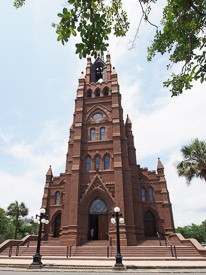 |  | 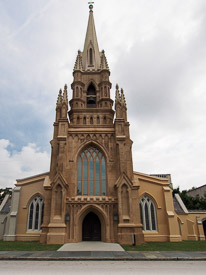 |
| Cathedral of St John the Baptist 120 Broad Street South Broad Built in 1890 | St Philip's Episcopal Church | Grace Episcopal Church 98 Wentworth Street Harleston Village Built 1846 |
 |  | 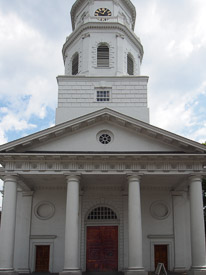 |
| Unitarian Church 4 Archdale Street Business District Built 1787 Oldest Unitarian church in the south | French Protestant Church 136 Church Street French Quarter Built 1845 First Gothic Rivival in Charleston | St Michael's Episcopal Church 71 Broad Street South of Broad Built between 1752 - 1761 |
 | 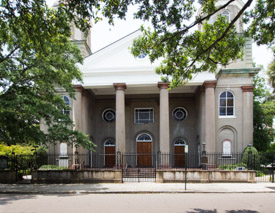 | 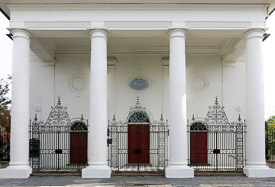 |
First Baptist Church | First Scots Presbyterian Church South of Broad 53 Meeting Street Built in 1814 Fifth oldest church in Charleston | St John's Lutheran Church Business District 5 Clifford Street Built between 1816 - 1818 |
Social Share
Local Information
Most popular content
Nearby Towns
- Edisto Island, SC - 45 mi 1.0 hr
- Folly Beach, SC - 21 mi 0.4 hrs
- Hilton Head, SC - 99 mi 2.0 hrs
- Isle of Palms, SC - 18 mi 0.6 hrs
- James Island, SC - 5 mi 0.3 hrs
- John's Island SC - 11 mi 0.5 hrs
- Moncks Corner, SC - 35 mi 0.7 hrs
- Myrtle Beach, SC - 95 3.0 hrs
- Savannah, GA - 107 mi 2.0 hrs
- Seabrook Island, SC - 24 mi 0.6 hrs
- Sullivans Island, SC - 10 mi 0.4 hrs
- Summerville, SC - 28 mi 0.5 hrs
- Tybee Island, GA - 125 mi 3.0 hrs
- Wadmalaw Island, SC - 19 mi 1.0 hr
- For Web Designs -
More websites for "Fun things to do"
Disclaimer
This is a private, "unofficial", website for visitors and is unrelated to and independent of any "official" websites.
Note that it is also a mobile friendly website; suitable for access with iPhones, iPads, tablets, and other mobile devices.
